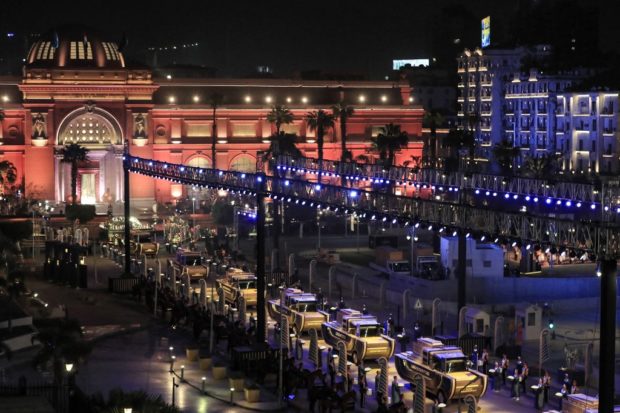Egyptian mummies paraded through Cairo on way to new museum

The carriages carrying 22 ancient Egyptian royal mummies depart from the Egyptian Museum in Cairo’s Tahrir Square on April 3, 2021, during a parade on their way to their new resting place at the new National Museum of Egyptian Civilisation (NMEC) about seven kilometres south in historic Fustat (Old Cairo). – Dubbed the Pharaohs’ Golden Parade, the 18 kings and four queens will travel in order, oldest first, each aboard a separate float decorated in ancient Egyptian style. (Photo by Khaled DESOUKI / AFP)
CAIRO — A grand parade conveyed 22 ancient Egyptian royal mummies in special capsules across the capital Cairo on Saturday to a new museum home where they can be displayed in greater splendor.
The convoy transported 18 kings and four queens, mostly from the New Kingdom, from the Egyptian Museum in central Cairo’s Tahrir Square to the National Museum of Egyptian Civilization in Fustat, about 5km (3 miles) to the south-east.
Authorities shut down roads along the Nile for the elaborate ceremony, designed to drum up interest in Egypt’s rich collections of antiquities when tourism has almost entirely stalled because of COVID-19 related restrictions.
As the royal mummies arrived at the museum, which was officially inaugurated on Saturday, cannons fired a 21-gun salute. President Abdel Fattah al-Sisi stood by as the mummies filed past on vehicles bedecked with golden pharaonic motifs.
The heads of the U.N. cultural agency Unesco and the World Tourism Organization were also present at the ceremony.
Article continues after this advertisementEach mummy had been placed in a special capsule filled with nitrogen to ensure protection, Egyptian archaeologist Zahi Hawass said.
Article continues after this advertisementThey were carried on vehicles designed to cradle them and provide stability.
‘Civilized’ display
“We chose the Civilization Museum because we want, for the first time, to display the mummies in a civilized manner, an educated manner, and not for amusement as they were in the Egyptian Museum,” Hawass said.
Archaeologists discovered the mummies in two batches at the complex of mortuary temples of Deir Al Bahari in Luxor and at the nearby Valley of the Kings from 1871.
The oldest is that of Seqenenre Tao, the last king of the 17th Dynasty, who reigned in the 16th century BC and is thought to have met a violent death.
The parade also included the mummies of Ramses II, Seti I, and Ahmose-Nefertari.
Fustat, the home of the new museum, was the site of Egypt’s capital under the Umayyad dynasty after the Arab conquest.
“By doing it like this, with great pomp and circumstance, the mummies are getting their due,” said Salima Ikram, an Egyptologist at the American University in Cairo.
“These are the kings of Egypt, these are the pharaohs. And so, it is a way of showing respect.”